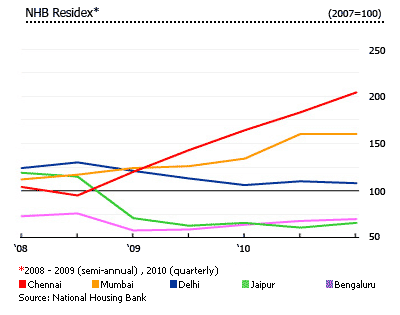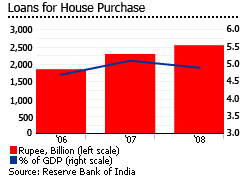India's housing markets mixed
Interest rate rises are beginning to bite in India, and housing markets in major cities weakened in 2010.
Yet this hasn’t broken the clear pattern since the relaunch of the National Housing Bank residential property index (NHB Residex) in 2007:
- successful growing cities have seen house prices rise rapidly (Chennai, Mumbai, Pune, Faridabad)
- prices in some other cities have fallen strongly (Jaipur, Hyderabad, Kochi, Bengalaru).

The contrasts are really striking. House prices have more than doubled in Chennai from 2007 to today (with the index moving from 100 to 204). During the same period the house price index fell from 100 to 66 in Jaipur.
One explanation is that cities relying mainly on electronics and manufacturing suffered most during the global financial crisis, while cities with offshoring and business process outsourcing (BPO) showed resiliency – but that is not the whole story, and does not explain the strong house-price falls over the past 4 years in Bengalaru (now recovering).
CITYWISE INDEX |
||||||||
| CITIES | 2007 Index | Jan-June 2008 Index | July- Dec 2008 Index | Jan-June 2009 Index | July-Dec 2009 Index | Jan-Mar 2010 Index | Apr-Jun 2010 Index | July-Sep 2010 (P) Index |
| Hyderabad | 100 | 96 | 98 | 65 | 81 | 81 | 82 | 88 |
| Faridabad | 100 | 100 | 121 | 139 | 145 | 154 | 152 | 146 |
| Patna | 100 | 103 | 100 | 107 | 119 | 127 | 124 | 124 |
| Ahmedabad | 100 | 106 | 100 | 127 | 128 | 113 | 131 | 127 |
| Chennai | 100 | 104 | 95 | 120 | 143 | 164 | 183 | 204 |
| Jaipur | 100 | 119 | 115 | 71 | 63 | 66 | 61 | 66 |
| Lucknow | 100 | 103 | 102 | 104 | 119 | 112 | 133 | 116 |
| Pune | 100 | 101 | 97 | 103 | 117 | 124 | 135 | 145 |
| Surat | 100 | 101 | 98 | 111 | 123 | 109 | 136 | 107 |
| Kochi | 100 | 106 | 95 | 90 | 83 | 79 | 83 | 80 |
| Bhopal | 100 | 139 | 151 | 139 | 162 | 158 | 153 | 142 |
| Kolkata | 100 | 114 | 140 | 162 | 185 | 165 | 176 | 171 |
| Mumbai | 100 | 112 | 117 | 124 | 126 | 134 | 160 | 160 |
| Bengaluru | 100 | 73 | 76 | 58 | 59 | 64 | 68 | 70 |
| Delhi | 100 | 24 | 130 | 121 | 113 | 106 | 110 | 108 |
| Source: NHB Residex | ||||||||
House prices still rising in some cities
Prices are still rising in Chennai (+11.5% on a quarter-on-quarter basis), and Bengaluru (India’s Silicon Valley and third largest city, +2.9%). In Mumbai and Katna, house prices were unchanged from Q2 to Q3 2010.
House prices fell q-o-q in eight of the 15 major cities covered by the NHB Residex. Declines ranged from -1.8% for Delhi, -2.8% for Kolkata to -21.3% in Surat (the capital of Gujarat state in eastern India). The Residex only started publishing quarterly figures in 2010; from 2008 to 2009 the index was updated semi-annually.
Compared to last year :
- Property prices are sharply up in five cities (Chennai +43%, Mumbai +27%, Pune +24%, Bengaluru +19% and Hyderabad +8.6%).
- Cities which suffered included Bhopal (-12%), Surat (13%), Kolkata (-7.6%) and Delhi (-4.4%).
Property prices in Mumbai’s luxury segment continue to surge. The luxury residential property index based on capital values rose 2.8% q-o-q and 14.9% y-o-y to Q4 2010, according to Jones Lang LaSalle (JLL), an international real estate consultancy firm.
Housing bubble trouble
Indian house prices rose rapidly from 2002 to 2007. Strong economic growth and urbanization supported house prices, while in city centres a housing bubble was encouraged by inadequate infrastructure, lack of planning and antiquated land use laws.
From 2005 to 2007, the Indian economy grew annually at 8.9% per annum, making the country one of the world’s fastest growing, after 7.6% per annum growth from 2003 to 2004.
The liberalization of major sectors of the Indian economy during the early 1990s brought a rapid influx of foreign direct investment (FDI). A boom in the ICT and BPO industry generated rapid employment growth, increasing demand for housing, and caused a ripple effect in the construction and telecommunications sectors.
Yet although house price increases were supported by these strong fundamentals, speculation also played a role. From 2000 to 2006, residential property became significantly less affordable. By 2002, a residential property in Mumbai cost around 85 times the average annual average income. By 2006, residential properties in Mumbai cost 100 times the average annual income.
The capital of developers rapidly grew as their stock prices increased. Developers used the capital to bid high prices for huge plots of land, making it relatively easy to sell properties at very high prices.
The impact of the global crisis
In the global downturn of 2008, developers resorted to rounds of price cuts, and introduced lucrative deals, with subsidized furniture and internet connections.
Demand for luxury housing fell 50%, while affordable housing demand fell 10%, according to a May 2009 survey by the Associated Chambers of Commerce and Industry of India (Assocham), the umbrella body of chambers of commerce in India.
Developers refocused on low-income houses.
Mortgage market handicapped by bad laws

Indian buyers usually pay for apartments before construction has been completed. Many buyers do not take out mortgage loans (the ratio of housing loans to GDP is less than 5% in India).
There are two main payment options.
- Lump-sum payment mode: buyers pay up to 95% of cost of the unit.
- Construction-linked payment mode: buyers pay at different stages of construction.
Despite the financial sector reforms since 1991, the expansion of the mortgage market has been held back by problems:
- Banks prefer to lend to middle and high-income sectors, leaving limited financing options for low-income individuals.
- The government has a huge influence on major domestic banks, discouraging initiative.
- There’s no proper legal framework for foreclosures
- There are rampant titling problems.
The loan to value (LTV) of most Indian home loans is 85%. Recently, LTVs were reduced to 75% at LIC Housing Finance, and 80% at the Housing Finance Development Corporation (HDFC), two major housing finance institutions. Other financing institutions seem likely to follow suit if house prices continue to decline.
Yields are low in India
The most negative indicator for India’s market is that residential yields are very low. The Global Property Guide believes that, on balance, that good capital gains are much more likely in high yielding markets, than in housing markets with low yields:
- Monthly rents in Mumbai are expensive, at US$8,000 to US$11,500 per month, and yet yields are poor at 3.5% to 4.6%.
- Rents in Delhi are cheaper at US$2,000 to US$3,000 per month, but yields are also low, at 2.9% to 4%.
- Annual yields in Bangalore are relatively higher than Delhi and Mumbai, at an average of 4.6%.
The Indian rental market is hindered by problematic socialist laws protecting tenants. The laws are generally poorly conceived and ineffective, making implementation difficult. Although these laws are gradually being replaced by more market-oriented laws, the rental market’s full potential is yet to be realized.
Cities with rent controls generate lower yields. Mumbai rents in houses with sitting tenants are frozen at their 1947 levels, due to the Maharashtra Rent Act of 1999, an extension of the Bombay Rent Control Act of 1947. Delhi also has rent controls.